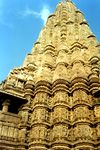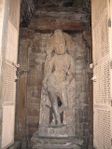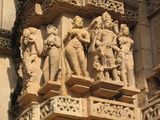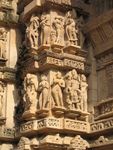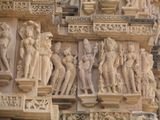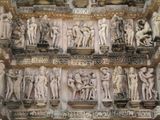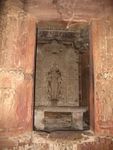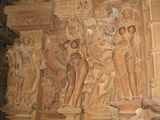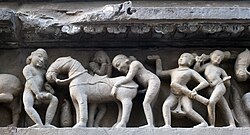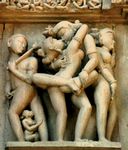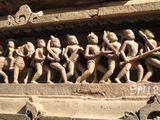Khajuraho Group of Monuments: Difference between revisions
| Line 236: | Line 236: | ||
== Recent discovery == | == Recent discovery == | ||
The Archaeological Survey of India has recently{{when|date=November 2010}} started digging on a mound where perhaps the largest underground temple in Khajuraho has been unearthed. The dig will take at least a couple of years to conclude.<ref>http://www.iloveindia.com/indian-monuments/khajuraho-temples.html</ref> | The Archaeological Survey of India has recently{{when|date=November 2010}} started digging on a mound where perhaps the largest underground temple in Khajuraho has been unearthed. The dig will take at least a couple of years to conclude.<ref>http://www.iloveindia.com/indian-monuments/khajuraho-temples.html</ref> | ||
The M P Tourism Development has set up kiosks at the Railway Station itself, (which is 9kms away from the city) with helpful tourist officers to guide the travellers. | |||
The temples in Khajuraho are broadly divided into three parts : the Eastern group, the Southern Group and the Western group of temples of which the Western group alone has the facility of an Audio guided tour wherein the tourists are guided through the seven eight temples. The Audio guided tour being developed by the Archaelogical Survey of India offers a very informative narration of the historical data related to the temples. At a very reasonable price, it offers the best possible way to take the tour. | |||
== See also == | == See also == | ||
Revision as of 07:41, 11 September 2012
| UNESCO World Heritage Site | |
|---|---|
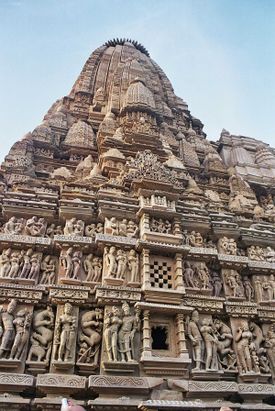 | |
| Criteria | Cultural: i, iii |
| Reference | 240 |
| Inscription | 1986 (10th session) |
The Khajuraho Group of Monuments in Khajuraho, a town in the Indian state of Madhya Pradesh, located in Chhatarpur District, about 620 kilometres (385 mi) southeast of New Delhi, is one of the most popular tourist destinations in India. Khajuraho has the largest group of medieval Hindu and Jain temples, famous for their erotic sculptures.
The name Khajuraho, ancient "Kharjuravāhaka", is derived from the Sanskrit words kharjura = date palm and vāhaka = "one who carries". In the 19th century, British engineer T.S. Burt arrived in the area, followed by General Alexander Cunningham. Cunningham put Khajuraho on the world map when he explored the site on behalf of the Archaeological Survey of India and described what he found in glowing terms. The Khajuraho Group of Monuments has been listed as a UNESCO World Heritage Site, and is considered to be one of the "seven wonders" of India.
Town
Script error: No such module "Settlement short description".
Khajuraho | |
|---|---|
city | |
| Country | India |
| State | Madhya Pradesh |
| District | Chhatarpur |
| Elevation | Template:Infobox settlement/lengthdisp |
| Population (2001) | |
| • Total | 19,282 |
| • Density | Template:Infobox settlement/densdisp |
| Languages | |
| • Official | Hindi |
| Time zone | UTC+5:30 (IST) |
Khajuraho is a town in the Indian state of Madhya Pradesh, located in Chhatarpur District, about 620 kilometres (385 mi) southeast of New Delhi[1], the capital city of India. According to the 2001 India census,[2] Khajuraho has a population of 19,282. Males constitute 52% of the population and females 48%. The town has an average literacy rate of 53%, lower than the national average of 59.5%: male literacy is 62%, and female literacy is 43%. In Khajuraho, 19% of the population is under 6 years of age. Khajuraho is located at Lua error: callParserFunction: function "#coordinates" was not found.[3] and has an average elevation of 283 metres (928 feet).
There is also an active airport operating in the town, named Khajuraho Airport Template:Airport codes.
History
Some Bargujar Rajputs moved eastward to central India; they ruled over the Northeastern region of Rajasthan, called Dhundhar, and were referred to as Dhundhel or Dhundhela in ancient times, for the region they governed. Later on they called themselves Chandelas; those who were in the ruling class having gotra Kashyap were definitely all Bargujars; they were vassals of Gurjara - Pratihara empire of North India, which lasted from 500 C.E. to 1300 C.E. and at its peak the major monuments were built. The Bargujars also built the Kalinjar fort and Neelkanth Mahadev temple, similar to one at Sariska National Park, and Baroli, being Shiva
The city was the cultural capital of Chandel Rajputs, a Hindu dynasty that ruled this part of India from the 10-12th centuries. The political capital of the Chandelas was Kalinjar. The Khajuraho temples were built over a span of 200 years, from 950 to 1150. The Chandela capital was moved to Mahoba after this time, but Khajuraho continued to flourish for some time. Khajuraho has no forts because the Chandel Kings never lived in their cultural capital.The Matangeshwar Shiva temple was Built by King Chanradeo Chandel Dynasty of Rajpoot,the King was devotee of lord Matangeshwar Shiva,there is 8 feet Linga of Lord Shiva in temple,,The MATANGDEV was the 10th Incarnation of Lord Shiva.The Matangdev was born in Patna/ Pataliputra town which is historical city of Bihar state of India,Maheshwary community of Sindh, Gujarat and Maharashtra are the devotee of lord Matangdev which is known as Matangeshwar Shiva and also known as MAHESHWAR SHIVA, Matrunjay Shiva, so that Maheshwary caste is attached with Maheshwar Shiva,Temple is known for its Art Sculpture and statue and is tourist attraction and world famous temples. The Matangeshwar Shiva Preached to poor Tribal Sinbharia MAHESHWARY MEGHWAR caste of Sindh, Pakistan and kutch and Jamnagar Bhav nagar regions of Gujarat state of India, and given the dharma and path of happiness to poor Sinbharia Meghwar and he formulated ancient Barmati dharma. and the NIRVAN destination of MATANGDEV is in SHENI THAR Sindh Pakistan.Shenithar is the Sacred pilgrimage of maheshwary Meghwar,The temple of Matangeshwar in Khajuraho UNESCO world heritage site,Reference http://mamaidev.vinzoda.in The whole area was enclosed by a wall with eight originates, each flanked by two golden palm trees. There were originally over 80 Hindu temples, of which only 25 now stand in a reasonable state of preservation, scattered over an area of about 20 square kilometres (8 sq mi). Today, the temples serve as fine examples of Indian architectural styles that have gained popularity due to their explicit depiction of sexual life during medieval times. Locals living in the Khajuraho village always knew about and kept up the temples as best as they could. They were pointed out to an Englishman in late 19th century but the jungles had taken a toll on all the monuments.
Architecture

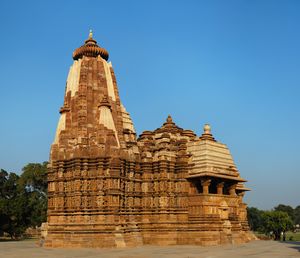
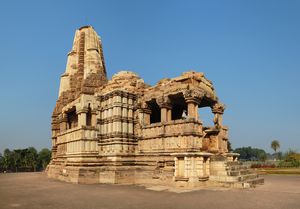
The temples are grouped into three geographical divisions: western, eastern and southern.
The Khajuraho temples are made of sandstone. The builders didn't use mortar: the stones were put together with mortise and tenon joints and they were held in place by gravity. This form of construction requires very precise joints. The columns and architraves were built with megaliths that weighed up to 20 tons.[4]
The Saraswati temple on the campus of the Birla Institute of Technology and Science in Pilani, India, is modeled after the Khajuraho temples.
Chronology
The temples have been assigned the following historical sequence by Dr. Kanhaiyalal Agrawal.[5]
| Sequence | Modern name | Original Deity | Note |
| 1 | Chausath Yogini | 64 Yoginis | Est 9th c. |
| 2 | Brahma | Brahma | Eastern group |
| 3 | Lalgun Mahadev | Shiva | Contemp to 2 |
| 4 | Matangeshwar | Shiva | In active worship |
| 5 | Varaha | Varaha | |
| 6 | Lakshman | Vaikuntha Vishnu | Lakshavarma Inscription |
| 7 | Parshvanath | Adinath | Pahil inscription 954 AD, Jain Compound |
| 8 | Vishvanath | Shiva | Dhanga inscription Sam 1059 |
| 9 | Devi Jagadambi | Initially Vishnu but today Parvati | |
| 10 | Chitragupta | Surya | |
| 11 | Kandariya Mahadeva | Shiva | Largest |
| 12 | Vamana | Vamana | Eastern Group |
| 13 | Adinath | Jina | Jain compound |
| 14 | Jawari | Vishnu | Eastern group |
| 15 | Chaturbhuja | Vishnu | Southern |
| 16 | Dulhadeo | Shiva | South end |
| 17 | Ghantai | Jina | Only some columns remaining |
Statues and carvings
The Khajuraho temples contain some sexual or erotic art outside the temple or near the deities. Also, some of the temples that have two layers of walls have small erotic carvings on the outside of the inner wall. There are many interpretations of the erotic carvings. It has been suggested that these suggest tantric sexual practices. Meanwhile, the external curvature and carvings of the temples depict humans, human bodies, and the changes that occur in bodies, as well as facts of life. Some 10% of the carvings contain sexual themes; those reportedly do not show deities: They show sexual activities between people. The rest depict the everyday life of the common Indian when the carvings were made and activities of other beings. For example, those depictions show women putting on makeup, musicians, potters, farmers, and other folk. The mundane scenes are all at some distance from the temple deities. A common misconception is that, since the old structures with carvings in Khajuraho are temples, the carvings depict sex between deities.[6]
Another perspective of these carvings is presented by James McConnachie. In his history of the Kamasutra, McConnachie describes the zesty 10% of the Khajuraho sculptures as "the apogee of erotic art":
"Twisting, broad-hipped and high breasted nymphs display their generously contoured and bejewelled bodies on exquisitely worked exterior wall panels. These fleshy apsaras run riot across the surface of the stone, putting on make-up, washing their hair, playing games, dancing, and endlessly knotting and unknotting their girdles....Beside the heavenly nymphs are serried ranks of griffins, guardian deities and, most notoriously, extravagantly interlocked maithunas, or lovemaking couples."
-
Kandariya Mahadeva temple
-
Chaturbuj Temple
-
Lakshman temple
-
Lakshman temple
-
Lakshman temple
-
Lakshman temple
-
Lakshman temple
-
Lakshman temple
-
Erotic scene with a horse - Lakshman temple
-
A temple relief at Khajuraho in Madhya Pradesh, India features a couple in a sexual embrace with a man and a woman masturbating to either side.
-
Outside wall of one of the temples
While the sexual nature of these carvings have caused the site to be referred to as the Kamasutra temple, they do not illustrate the meticulously described positions. Neither do they express the philosophy of Vatsyayana's famous sutra. As "a strange union of Tantrism and fertility motifs, with a heavy dose of magic" they belief a document which focuses on pleasure rather than procreation. That is, fertility is moot.[citation needed]
The strategically placed sculptures are "symbolical-magical diagrams, or yantras" designed to appease malevolent spirits. This alamkara (ornamentation) expresses sophisticated artistic transcendence over the natural; sexual images imply a virile, thus powerful, ruler.[7]
Between 950 and 1150, the Chandela monarchs built these temples when the Tantric tradition may have been accepted. In the days before the Mughal conquests, when boys lived in hermitages, following brahmacharya until they became men, they could learn about the world and prepare themselves to become householders through examining these sculptures and the worldly desires they depicted.[citation needed]
While recording the television show Lost Worlds (History Channel) at Khajuraho, Alex Evans, a contemporary stonemason and sculptor gave his expert opinion and forensically examined the tool marks and construction techniques involved in creating the stunning stonework at the sites. He also recreated a stone sculpture under 4 feet that took about 60 days to carve in an attempt to develop a rough idea how much work must have been involved.[8] Roger Hopkins and Mark Lehner also conducted experiments to quarry limestone which took 12 quarrymen 22 days to quarry about 400 tons of stone.[9] These temples would have required hundreds of highly trained sculptors.
Landscape
The Khajuraho temples are now set in a parkland landscape. When India gained independence from Britain in 1947 the landscape setting was semi-desert and scrub. The archaeological park now has something of the character of a public park, with mowed grass, rose beds and ornamental trees. This design is aimed for tourists comfort but has no relationship with the historic landscape at the time the temples were built.
The development of landscape archaeology as an academic discipline raises questions concerning the earlier landscape of Khajuraho and the original relationship between the temple complex and the surrounding area. There are no records of what the original landscape might have been, but it is known that a large community of priests used the temple complex and that Indian gardens in the tenth century were predominantly tree gardens. They did not have lawns or herbaceous flowering plants.
Tourism and cultural events
The Khajuraho temple complex offers a professional light and sound show every evening. The first show is in English language and the second one in Hindi[10]. The show is about an hour long and covers the history, philosophy and the art of sculpting of these temples. It is held in the open lawns in the temple complex.
The Khajuraho Dance Festival, held every year in the first week of February (1st to 7th), is an opportunity for visitors to experience various classical Indian dances set against the backdrop of the Chitragupta or Vishwanath Temples.
Recent discovery
The Archaeological Survey of India has recently[when?] started digging on a mound where perhaps the largest underground temple in Khajuraho has been unearthed. The dig will take at least a couple of years to conclude.[11] The M P Tourism Development has set up kiosks at the Railway Station itself, (which is 9kms away from the city) with helpful tourist officers to guide the travellers. The temples in Khajuraho are broadly divided into three parts : the Eastern group, the Southern Group and the Western group of temples of which the Western group alone has the facility of an Audio guided tour wherein the tourists are guided through the seven eight temples. The Audio guided tour being developed by the Archaelogical Survey of India offers a very informative narration of the historical data related to the temples. At a very reasonable price, it offers the best possible way to take the tour.
See also
- Bambar Baini the famous temple located on a hill in Laundi.
- Kandariya Mahadeva
- Hemvati
- Beejamandal
- Jain temples of Khajuraho
- List of megalithic sites
- Bandhavgarh National Park
References
- ↑ Khajuraho
- ↑ Template:GR
- ↑ Falling Rain Genomics, Inc - Khajuraho
- ↑ "Lost Worlds of the Kama Sutra" History channel
- ↑ Khajuraho, Kanhaiyalal Agrawal, Macmillan India, 1980 (in Hindi)
- ↑ "Khajuraho", liveindia.com
- ↑ McConnachie, James (2005). The Book of Love, the Story of the Kamasutra. Metropolitan Press. pp. 46–47.
- ↑ "Lost Worlds of the Kama Sutra," History Channel
- ↑ Lehner, Mark, The Complete Pyramids, London: Thames and Hudson (1997) p. 202-225 ISBN 0-500-05084-8.
- ↑ Khajuraho
- ↑ http://www.iloveindia.com/indian-monuments/khajuraho-temples.html
Further reading
- Phani Kant Mishra, Khajuraho: With Latest Discoveries, Sundeep Prakashan (2001) ISBN 81-7574-101-5
- Devangana Desai, The Religious Imagery of Khajuraho, Franco-Indian Research P. Ltd. (1996) ISBN 81-900184-1-8
- Devangana Desai, Khajuraho, Oxford University Press Paperback (Sixth impression 2005) ISBN 978-0-19-565643-5
External links
bn:খাজুরাহো bg:Кхаджурахо ca:Khajuraho cs:Khadžuráho de:Khajuraho el:Κχατζουράχο (Μνημεία) es:Khajuraho eo:Khaĝuraho fa:خاجوراهو fr:Khajurâho gu:ખજુરાહો ko:카주라호 hi:खजुराहो hr:Khajuraho bpy:খাজুরাহ id:Khajuraho it:Khajuraho he:קהאג'וראהו kn:ಖಜುರಾಹೊ ka:ქაჯურაჰო hu:Khadzsuráhó ml:ഖജുരാഹോ mr:खजुराहो xmf:ქაჯურაჰო nl:Khajuraho ne:खजुराहो new:खजुराहो ja:カジュラーホー pl:Khajuraho pt:Conjunto de Templos de Khajuraho ru:Кхаджурахо sr:Кхајурахо sh:Khajuraho fi:Khajuraho sv:Khajuraho ta:கஜுராஹோ te:ఖజురహో వద్ద నిర్మాణ సమూహాలు uk:Кхаджурахо vi:Khajuraho zh:克久拉霍
- Pages using infobox UNESCO World Heritage Site with unknown parameters
- Pages using infobox settlement with unknown parameters
- All articles with unsourced statements
- Articles with unsourced statements from August 2012
- Articles with invalid date parameter in template
- Articles needing additional references from August 2012
- All articles needing additional references
- All articles with vague or ambiguous time
- Vague or ambiguous time from November 2010
- Commons category link is locally defined
- Hindu World Heritage Sites
- Hindu holy cities
- Bundelkhand
- Monuments and memorials in Madhya Pradesh
- Chhatarpur district
- World Heritage Sites in India
